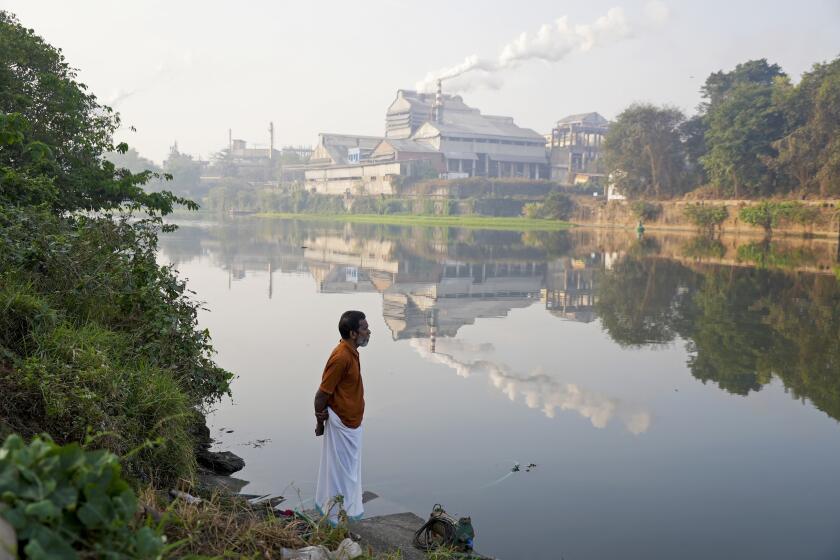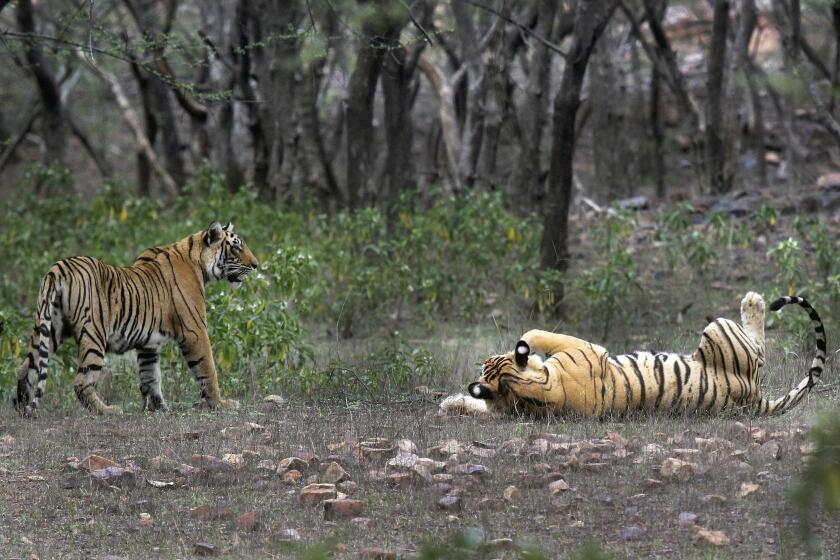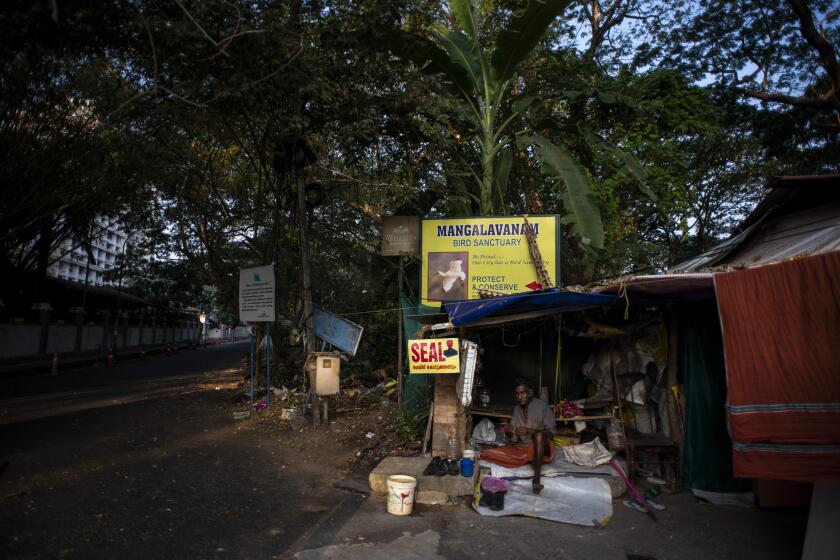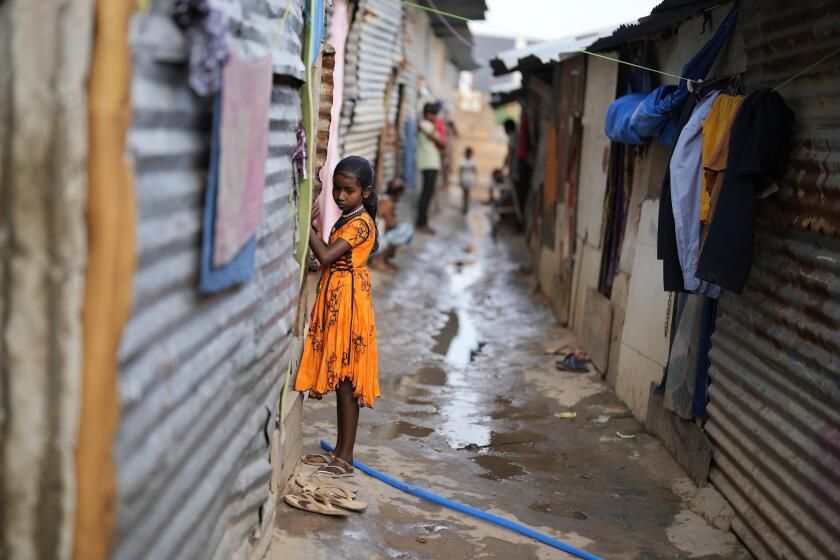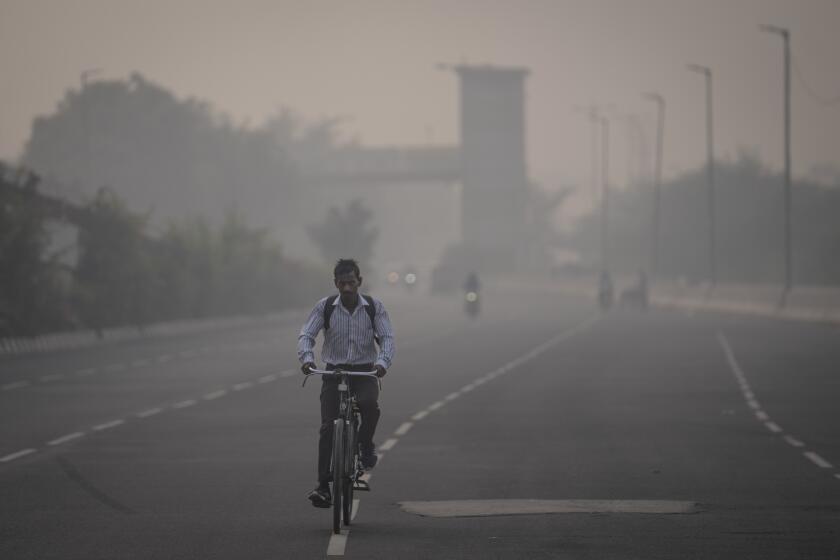Indigenous faithful and Christians work with environmentalists to conserve India’s sacred forests
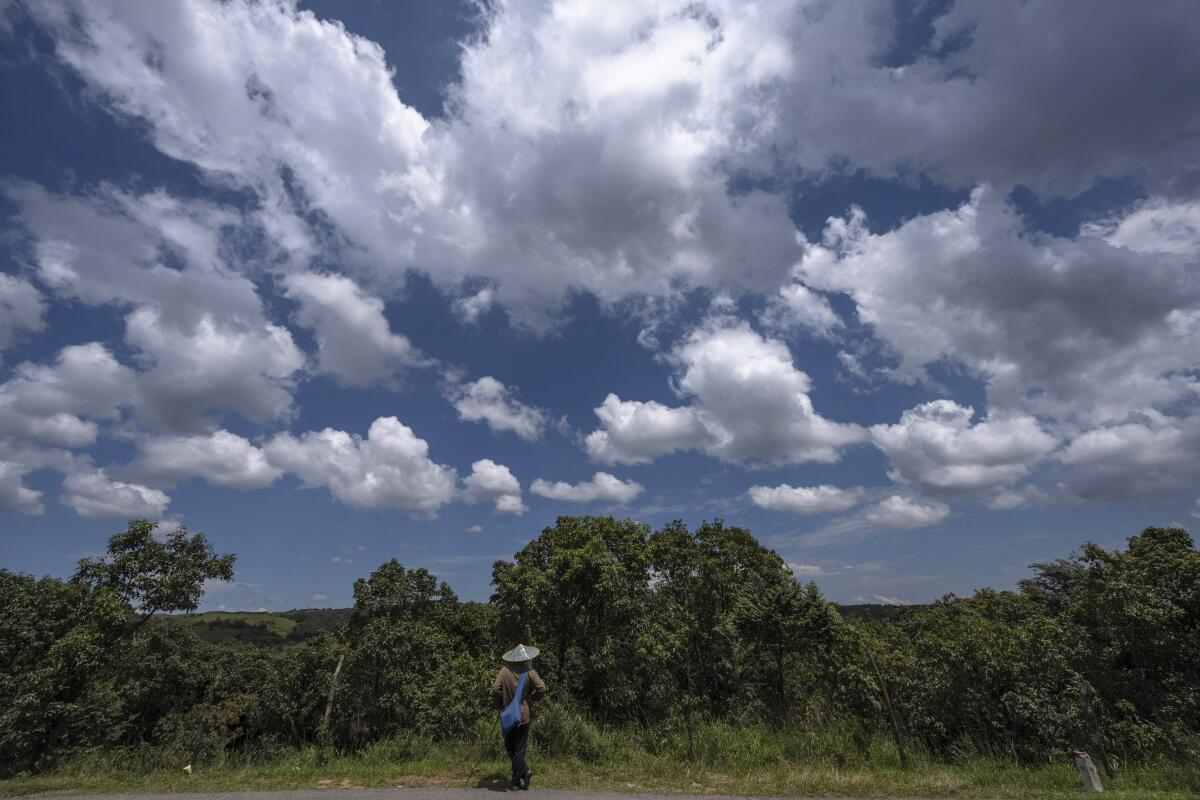
- Share via
SHILLONG, India — Tambor Lyngdoh made his way through the fern-covered woodland — naming plants, trees, flowers, even stones — as if he were paying older family members a visit.
The community leader and entrepreneur was a little boy when his uncle brought him here and said these words: “This forest is your mother.”
This sacred space is in the village of Mawphlang, nestled in the verdant Khasi Hills in the northeast Indian state of Meghalaya, whose name means “abode of clouds.” On an overcast day, the forest, a bumpy 15-mile drive from the state capital of Shillong, was tranquil but for the sound of crickets chirping and raindrops rustling the bright green foliage.
The ground, carpeted by dead leaves and green saplings, was peppered with moss-covered sacred stones, which for centuries have served as sacrificial altars and recipients of chants, songs and prayers.
Mawphlang is one of more than 125 sacred forests in Meghalaya, and arguably the most famous one. These forests are ancient, virgin woodlands that have been protected by Indigenous communities for many centuries; comparable tracts have been documented in other parts of India and around the globe, from Nigeria and Ethiopia to Turkey, Syria and Japan.
Eloor, a small island on the Periyar River in southern India, used to have rich farmland and be teeming with fish.
In Meghalaya, these forests represent an ancient tradition of environmental conservation, rooted in Indigenous religious beliefs and culture. For hundreds of years, people have come to sacred groves to offer prayers and animal sacrifice to the deities they believe reside there. Any form of desecration is taboo; in most forests, even plucking a flower or leaf is prohibited.
“Here, communication between man and God takes place,” said Lyngdoh, a descendant of the priestly clan that sanctified the Mawphlang forest. “Our forefathers set aside these groves and forests to signify the harmony between man and nature.”
Many of these forests are primary sources of water for surrounding villages. They are also treasure-troves of biodiversity. Lyngdoh counts at least four species of trees and three types of orchids that are extinct outside of the Mawphlang sacred grove.
Today, climate change, pollution and deforestation threaten these spaces. They have also been affected by the Indigenous population’s conversion to Christianity, which began in 19th century under British rule. Christian converts lost their spiritual connection to the forests and lore, said H.H. Mohrmen, an environmentalist and retired Unitarian minister. Meghalaya is 75% Christian in a country that is almost 80% Hindu.
“They viewed their new religion as the light and these rituals as darkness, as pagan or even evil,” he said.
Wildlife conservation initiatives, including Project Tiger, have forced Indigenous people out of forests and hurt their livelihoods, protesters say.
In recent years, environmentalists working with Indigenous and Christian communities as well as government agencies have helped spread the message about why the forests, invaluable to the region’s ecosystem and biodiversity, must be tended. Mohrmen said that work is bearing fruit in rural communities.
“We’re now finding that even in places where people have converted to Christianity, they are taking care of the forests,” Mohrmen said.
Mustem village in Jaintia Hills is one example. Heimonmi Shylla, headman of the hamlet with about 500 households and a deacon, says almost all residents are Presbyterian, Catholic or members of the Church of God.
“I don’t consider the forest holy,” he said. “But I have great reverence for it.”
It serves as the village’s source of drinking water and is a sanctuary for fish.
“When the weather gets really warm, the forest keeps us cool,” he said. “When you breathe in that fresh air, your mind becomes fresh.”
Shylla worries about climate change and insufficient rain, but he said there are plans to promote tourism and “make the forest greener” by planting more trees.
Petros Pyrtuh takes his 6-year-old son, Bari Kupar, to a sacred forest near his village, also in Jaintia Hills. He is Christian, but said the forest is an important part of his life; he hopes his son will learn to respect it.
Surging development is cutting deep into a mangrove forest in southern India known as the “green lung of Kochi,” squeezing the trees on all sides.
“In our generation, we don’t believe it is the dwelling place of the gods,” he said. “But we continue with the tradition of protecting the forest because our ancestors have told us not to defile the forest.”
B.K. Tiwari, a retired professor of environmental science from North Eastern Hill University in Shillong, is heartened to see that conversion to Christianity has not disconnected the people entirely from the land.
“In the Indigenous religion everything is sacred — animals, plants, trees, rivers,” said Tiwari, who has studied the biological and cultural diversity of Meghalaya’s sacred forests. “Now, they may not feel any connection with the divine or spiritual, but as a culture, they understand their roles as the custodians.”
Donbok Buam, a native of Jaintia Hills who still practices the Indigenous faith, explained that in his village’s sacred forest, rituals are performed at the confluence of three rivers honoring the goddess Lechki, denizen of the forest and guardian of the village.
“If people have a problem or sickness or if women have trouble conceiving children, they go there and perform sacrifices,” Buam said.
One of the rituals involves carrying river water before daybreak and offering it to the goddess at a specific location in the forest. The water is poured in gourds and placed alongside five betel nuts and five betel leaves — four for the rivers and one for the sacred forest. A white goat is sacrificed in honor of the forest deity, he said.
A flood in 2019 in an Indian state started Jerifa, her brother and their parents on a journey from their Himalayan village to a Bengaluru neighborhood.
“We believe the goddess walks in the forest, even today,” Buam said.
The Nongrum clan is one of three that cares for the Swer sacred forest near Cherrapunji, an area about 25 miles southwest of Shillong, which is among the wettest in the world. They follow the pantheistic Seng Khasi religion, which holds that God exists in everyone and everything. The forest is a temple where their deities reside, and rituals are performed to ward off war, famine and disease, said Knik Nongrum, president of the local committee that cares for the forest.
“When there is a healthy forest, there is prosperity in the village,” he said, vowing that this forest will continue to thrive because his clan is determined to carry on the traditions established by their ancestors.
Like most sacred forests, this one is not easily accessible from the road. It is up a steep hill whose terrain can become treacherous if hit by a downpour — as it frequently is. It is impossible to enter the forest without feeling the brush of twisted branches, breathing in the scent of flowers and herbs, and being showered by droplets of water shaken off leaves.
The part of the forest the people hold sacred is a leaf-covered plot surrounded by thick, tall trees.
Most of the rituals are performed only during turbulent times; the most recent tribulation was the global COVID-19 pandemic. One particular ritual — the sacrifice of a bull — is done by the head priest once in his lifetime, a practice that gives him authority to perform other rites for his community.
Masks are back on the streets of India’s capital as residents grapple with pollution levels that disrupt the lives of millions of people every year.
Jiersingh Nongrum, 52, pointed to the sacrificial altar just outside the forest, which has a crater in the middle where the animal’s blood pools. He was 6 when he witnessed that once-in-a-lifetime sacrifice.
“It was such an intense experience,” he said. “When I think about it today, it feels like a vision that I can’t even properly describe in words.”
Some sacred forests also serve as ancestral burial sites, said Hamphrey Lyngdoh Ryntathiang, the chief caretaker of one such forest in Khasi Hills. He practices the Khasi faith and his wife is Christian.
Each forest has its own set of rules and taboos. In this forest, people can take fruit from the trees, but are prohibited from burning anything, he said. In others, the fruit can be plucked from the tree, but must be eaten in the forest. Deities are believed to punish people for disturbances.
Lyngdoh from Mawphlang is Christian, but he participates in the forest rituals, invoking the deities believed to appear as a leopard and snake. He also sees the effects of climate change on forests in the area, and noted the invasive birds, fungi-infested trees and disappearing species.
In rural Meghalaya, the poorest people rely most on the land, said Lyngdoh, noting forests can be life-giving as well as economic engines, providing water and driving tourism.
“But above all, a sacred grove is set aside so we can continue to have what we have had from the time this world was created.”
More to Read
Sign up for Essential California
The most important California stories and recommendations in your inbox every morning.
You may occasionally receive promotional content from the Los Angeles Times.
